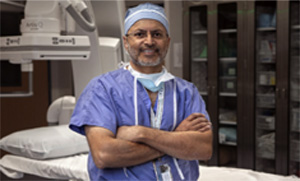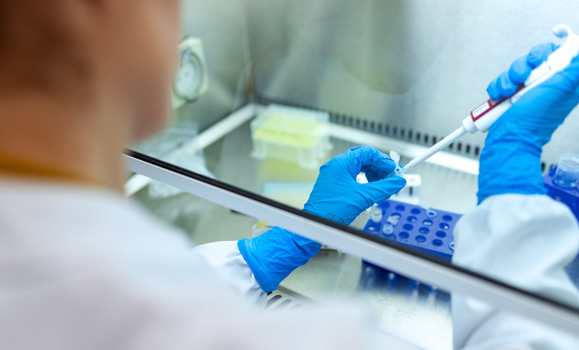Two years ago, Bill Revels was injected with millions of extremely small glass beads ‚ÄĒ an innovative medical procedure that ended up saving his life.
Revels had been diagnosed with liver cancer after experiencing pains in his side and back. ‚ÄúWhen I went into the hospital, I found I had a lesion on the liver,‚ÄĚ he says.
Doctors told Revels surgery wasn’t an option, and his first chemotherapy treatments were unable to stop the tumour’s growth. That’s when Dr. Bob Abraham called to inform Revels there was another option.
‚ÄúWith glass? That sounds kind of funny,‚ÄĚ Revels recalls telling the doctor over the phone after he explained the Y-90 radioembolization procedure. The procedure uses radiation-emitting glass beads to target a tumour directly while avoiding harm to other parts of the body.
 ‚ÄúHe was able to come in the morning have the procedure done. The procedure itself is painless and he didn‚Äôt even know that we had actually injected the therapy. He was able to go home that afternoon,‚ÄĚ says Dr. Abraham (pictured right), Revel‚Äôs treating physician and an interventional radiologist at the QEII.
‚ÄúHe was able to come in the morning have the procedure done. The procedure itself is painless and he didn‚Äôt even know that we had actually injected the therapy. He was able to go home that afternoon,‚ÄĚ says Dr. Abraham (pictured right), Revel‚Äôs treating physician and an interventional radiologist at the QEII.
The procedure is just one of the exciting opportunities possible with research in the biomaterials field ‚ÄĒ possibilities that researchers and doctors are hoping to expand upon with the creation of a new biomaterials lab at H¬ĢĽ≠ University to be funded by this year‚Äôs Molly Appeal campaign.
The annual fundraising campaign, led by the (DMRF), first started in 1980 when Molly Moore gave five dollars to the foundation ‚ÄĒ it‚Äôs first donation. Forty years later, the DMRF is still working to innovate in health care. This year, the foundation is asking Maritimers to help make a difference in the next generation of biomaterials research by giving what they can.
Improving care and patient outcomes
With the new Biomaterials Innovation Centre, researchers will work on a range of new treatments and products for conditions like Revel’s liver tumor to new orthopaedic implants.
‚ÄúWhat‚Äôs so exciting is that this lab will be able to touch so many disease processes and improve care and outcome of the patients that we treat in so many ways,‚ÄĚ says Dr. Abraham. ‚ÄúBiomaterials can be developed to be used in every part of the body and can improve treatments for so many diseases including cancer as we have seen with Y-90 therapy.‚ÄĚ
Revels says the only side effect after his Y-90 procedure: some tiredness for a few weeks after the treatment. Two years after the procedure he is able to live a normal, happy life.
‚ÄúIt‚Äôs one of the most rewarding things about my life. I‚Äôm able to make these kinds of differences with these patients,‚ÄĚ says Dr. Abraham. ‚ÄúTo be able to see him go back to work, be able to support [his] family, support himself and feel well after a diagnosis of liver cancer is truly amazing and a biomaterial is what has allowed this to happen.‚Ä̬†¬†

Dr. Abraham continues to work on the next step in the Y-90 radioembolization procedure.
‚ÄúWe actually are creating the next level of Y-90 therapy with new glass beads that are therapeutic but that you can actually visualize as we‚Äôre injecting,‚ÄĚ he says. Using a CT scan, doctors will be able to see the treatment as it works and verify its success as it happens. The new biomaterial used in the procedure will soon be entering a clinical trial.
Revels says he’s thankful to the doctors and researchers who work on these innovative procedures that turned his life around and is happy to share his success story to raise awareness about the impact the Molly Appeal can have.
‚ÄúWhat‚Äôs so great about this campaign and fundraising is that it‚Äôs going to bring a lot of very dedicated, passionate and talented people together in one location to create all these new products,‚ÄĚ says Dr. Abraham.
Through the Molly Appeal fundraising, and more innovative research emerging out of H¬ĢĽ≠ in the biomaterials field, there is hope for new life-changing procedures. If you‚Äôre interested in donating to the H¬ĢĽ≠ Medical Research Foundation, .

